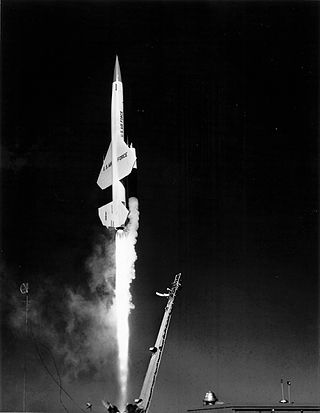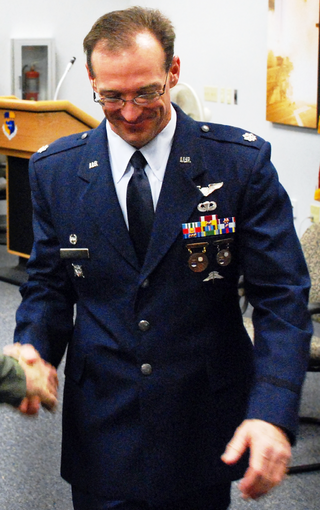
The Boeing CIM-10 Bomarc was a supersonic ramjet powered long-range surface-to-air missile (SAM) used during the Cold War for the air defense of North America. In addition to being the first operational long-range SAM and the first operational pulse doppler aviation radar, it was the only SAM deployed by the United States Air Force.

Strategic Air Command (SAC) was a United States Department of Defense Specified Command and a United States Air Force (USAF) Major Command responsible for command and control of the strategic bomber and intercontinental ballistic missile components of the United States military's strategic nuclear forces from 1946 to 1992. SAC was also responsible for strategic reconnaissance aircraft; airborne command posts; and most of the USAF's aerial refueling aircraft.

Minot Air Force Base is a United States Air Force (USAF) installation in Ward County, North Dakota, thirteen miles (20 km) north of the city of Minot via U.S. Route 83. In the 2020 census, the base was counted as a CDP with a total population of 5,017, down from 5,521 in 2010. Minot AFB is the home of two major wings: the 5th Bomb Wing and 91st Missile Wing, both of the Air Force Global Strike Command (AFGSC).

The Second Air Force is a USAF numbered air force responsible for conducting basic military and technical training for Air Force enlisted members and non-flying officers. In World War II the CONUS unit defended the Northwestern United States and Upper Great Plains regions and during the Cold War, was Strategic Air Command unit with strategic bombers and missiles. Elements of Second Air Force engaged in combat operations during the Korean War; Vietnam War, as well as Operation Desert Storm.

United States astronaut badges are the various badges of the United States which are awarded to military and civilian personnel of the National Aeronautics and Space Administration, the various child departments of the Department of Defense, or a private space-faring entity, who have performed a spaceflight. The military versions are among the least-awarded qualification badges of the United States armed forces.

Kincheloe Air Force Base was a United States Air Force (USAF) base during the Cold War. Built in the Upper Peninsula of Michigan in 1943 during World War II, the base was in service until 1977.

Insignias and badges of the United States Navy are military badges issued by the United States Department of the Navy to naval service members who achieve certain qualifications and accomplishments while serving on both active and reserve duty in the United States Navy. Most naval aviation insignia are also permitted for wear on uniforms of the United States Marine Corps.

Badges of the United States Air Force are specific uniform insignia authorized by the United States Air Force that signify aeronautical ratings, special skills, career field qualifications, and serve as identification devices for personnel occupying certain assignments.
The Air Force Specialty Code (AFSC) is an alphanumeric code used by the United States Air Force to identify a specific job. Officer AFSCs consist of four characters and enlisted AFSCs consist of five characters. A letter prefix or suffix may be used with an AFSC when more specific identification of position requirements and individual qualifications is necessary. The AFSC is similar to the Military Occupational Specialty Codes used by the United States Army and the United States Marine Corps or enlisted ratings and USN officer designators and Naval Officer Billet Classifications (NOBCs) used by the United States Navy and enlisted ratings and USCG officer specialties used by the United States Coast Guard. The United States Space Force equivalent is known as the Space Force Specialty Code (SFSC).
The Aircrew Badge, commonly known as Wings, is a qualification badge of the United States military that is awarded by all five branches of armed services to personnel who serve as aircrew members on board military aircraft. The badge is intended to recognize the training and qualifications required by aircrew of military aircraft. In order to qualify as an aircrew member and receive the Aircrew Badge, such personnel typically undergo advanced training in aircraft in-flight support roles.

A launch control center (LCC), in the United States, is the main control facility for intercontinental ballistic missiles (ICBMs). A launch control center monitors and controls missile launch facilities. From a launch control center, the missile combat crew can monitor the complex, launch the missile, or relax in the living quarters. The LCC is designed to provide maximum protection for the missile combat crew and equipment vital to missile launch. Missile silos are common across the midwestern United States, and over 450 missiles remain in US Air Force (USAF) service.

The Air Force Nuclear Weapons Center (AFNWC) is a USAF Named Unit, assigned to the Air Force Materiel Command at Kirtland Air Force Base, New Mexico. The AFNWC operates at the Center level of the AFMC. It is currently under the command of Major General John P. Newberry.

The 625th Strategic Operations Squadron (STOS) is a United States Air Force nuclear missile control & support squadron. The 625th STOS has five flights that play different roles in this mission. The Latin motto of the 625th STOS is Si vis pacem para bellum, which means, "If you wish for peace, prepare for war."

The Air Force Global Strike Command (AFGSC) is a Major Command (MAJCOM) of the United States Air Force, headquartered at Barksdale Air Force Base, Louisiana. AFGSC provides combat-ready forces to conduct strategic nuclear deterrence and global strike operations in support of combatant commanders. Air Force Global Strike Command is the Air Force's service component to the United States Strategic Command (USSTRATCOM).

The 6555th Aerospace Test Group is an inactive United States Air Force unit. It was last assigned to the Eastern Space and Missile Center and stationed at Patrick Air Force Base, Florida. It was inactivated on 1 October 1990.
The Nuclear Deterrence Operations Service Medal is a service medal of the United States Air Force and United States Space Force established on 27 May 2014. The medal recognizes service by personnel in various career fields who have served in units involved with national strategic nuclear deterrence operations. Officer and enlisted personnel in the Regular Air Force, Regular Space Force, Air Force Reserve, and Air National Guard communities are eligible for this medal. Eligible service is retroactive from 26 December 1991.

The 90th Missile Wing is a component of Twentieth Air Force, stationed at Francis E. Warren Air Force Base and equipped with LGM-30G Minuteman III Missiles. It has served at Warren as a component of Strategic Air Command, Air Combat Command, Air Force Space Command and Air Force Global Strike Command since 1963.
The Space Operations Badge is an occupational badge for guardians of the United States Space Force and space airmen of the United States Air Force while the United States Army (USA) version of the badge, known as the Space Badge, is a special skills badge for soldiers who qualify as space professionals.

Badges of the United States Space Force are specific uniform paraphernalia authorized by the United States Space Force that signify ratings, special skills, career field qualifications, and serve as identification devices for personnel occupying certain assignments. Space Force occupational badges are awarded in three degrees or skill levels. Badges for space operations are awarded at basic, senior, and command levels; other occupational badges are issued in basic, senior, and master level. A star and wreath system, worn above the badge, denotes which degree or skill level a service member currently holds.


















